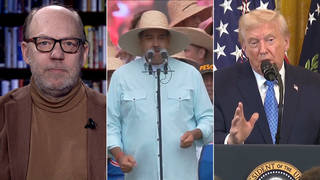
Topics
Guests
- Ted Shawdirector of the NAACP’s Legal Defense Fund. Four years ago, he was lead counsel for a coalition of African-American and Latino students in the University of Michigan undergraduate affirmative action admissions case. That year the Supreme Court ruled in favor of diversity as a compelling state interest and recognized race as one factor in the admissions process.
The narrow 5-4 ruling rejected using race as a criteria for assigning students for different schools, rejecting integration plans for school districts in Seattle, Washington, and Louisville, Kentucky. We speak with NAACP Legal Defense Fund Director Ted Shaw. [includes rush transcript]
Transcript
JUAN GONZALEZ: In a landmark decision Thursday, the Supreme Court voted against voluntary desegregation plans. The narrow 5-4 ruling rejected using race as a criteria for assigning students for different schools. It rejected integration plans for school districts in Seattle, Washington, and Louisville, Kentucky, and supported white parents from both cities, whose children had been denied admission to schools nearest to them because of those schools’ diversity policies.
The majority decision written by Chief Justice John Roberts says, “The way to stop discrimination on the basis of race is to stop discrimination on the basis of race.”
AMY GOODMAN: Dissenting Supreme Court judges criticized the decision as betraying the promise of the 1954 Brown v. Board of Education ruling that outlawed segregation in public schools. Justice John Paul Stevens wrote, “There is a cruel irony in the Chief Justice’s reliance on our decision in Brown v. Board of Education. … The Chief Justice rewrites the history of one of this Court’s most important decisions.” Justice Stephen Breyer wrote, “This is a decision that the Court and the nation will come to regret.”
Ted Shaw is the director of the NAACP’s Legal Defense Fund. Four years ago, he was lead counsel for a coalition of African-American and Latino students at the University of Michigan undergraduate affirmative action admissions case. That year, the Supreme Court ruled in favor of diversity as a compelling state interest and recognized race as one factor in the admissions process. Ted Shaw joins us now from Washington, D.C. Welcome to Democracy Now!
TED SHAW: Thank you, Amy.
AMY GOODMAN: It’s good to have you with us. Well, first, your reaction to this ruling, break it down for us.
TED SHAW: Well, I want to start with one small, but important, clarification. These cases out of Seattle, Washington, and Louisville, Kentucky, didn’t involve white parents who were suing because they were being sent to schools further away from home. There were broad choice elements, where students were choosing schools within their districts on a number of factors: the programs that were at those schools, the reputations of the schools. Choice was part of it already.
What these school districts were trying to do was overlay on all that choice the imperative to maintain some diversity or some degree of integration. You know, all that’s left of Brown v. Board of Education, for the most part, is voluntary integration, and days of mandatory busing are all but over. So, tragically yesterday, five justices on the Supreme Court voted to strike down those plans.
There was a nuance, or there are some nuances that make this a little bit more complicated, because Justice Kennedy, who’s perceived to be the swing vote on this new court now, given the replacements of two justices, former Chief Justice Rehnquist, who passed away, of course, and Justice O’Connor, who retired, Kennedy refused to join the Roberts plurality — that is, the four justices who wrote the opinion that was supposed to be the majority opinion — but he refused to join them, because he said he wouldn’t go so far as to say that you could never use race to try to desegregate public schools or maintain diversity. He has made it very hard in what he said to achieve the end that he said was legitimate. That does leave a window open of opportunity. But the question is going to be: What does that window allow? What does his opinion really mean going forward?
So while it was a defeat, it reminds me of Bakke in many ways, the Bakke decision, of course, which in 1978 sanctioned affirmative action in higher education, that was finally reaffirmed by the court in the Michigan cases. Bakke was not a 5-4 decision. It was a 4-4-1 decision, in which Justice Powell’s lone opinion eventually controlled and sustained affirmative action for 25 years. Now, we see that Justice Kennedy’s opinion is the one opinion, and the question is how much can it hold. So it’s not a complete loss. We don’t know, however, how much of a loss it is and won’t know for some time.
JUAN GONZALEZ: Ted, I’d like to ask you — there’s an op-ed piece by Juan Williams in today’s New York Times, the conservative African-American commentator, who basically says this: The Brown v. Board of Education case should be buried. It is a case from a previous era, that the issue right now is the quality schools for all children and, to a certain degree, continuing to focus on integration as the means to improve schools is losing focus. And he actually quotes discussions he had with Thurgood Marshall toward the end of his career about that. Your reaction to that?
TED SHAW: Well, first of all, Thurgood Marshall would be turning in his grave if he could read the opinions of the court that were handed down yesterday by the five justices in the majority. Juan Williams is becoming more and more conservative as time goes on, but essentially what his argument goes to is a return to the idea that racially separate schools can be made equal, and that’s never worked well in this country. The fact is, however — and maybe this is his point; if this is his point, then there may be something to it — the fact is, is that there are many schools that are going to be segregated because we’ve abandoned a lot of Brown v. Board of Education already in this country. When I say “we,” I mean collectively. The Legal Defense Fund has fought that abandonment. We continue to fight it. And we’re going to have to figure out how to provide quality education for all of our students — students of color, African-American students, in particular — no matter where they are. And many of them are going to be in segregated schools.
But where we can have diversity in public schools, where it’s possible to integrate those public schools, that’s something that should be done. To walk away from that is a tragic mistake, because, look, we live in a global economy in the 21st century. To be walking backwards toward segregation in public schools in the 21st century is madness. It undermines our credibility in the world, and, in fact, it undermines the capacity of students of color, particularly poor students of color, to access quality education. So, you know, I think that Thurgood Marshall — I know, because I lead the organization he led, and I know what he said from the bench when he was alive and what he devoted his life to — he would be turning in his grave with respect to yesterday’s opinion.
AMY GOODMAN: Ted Shaw, explain Brown v. Board of Education, since both sides use it as their defense.
TED SHAW: Well, that’s a good point, Amy. Look, Brown is iconic now. I mean, nobody would dare to challenge Brown on its face, although apparently Juan Williams is saying we should walk away from it. But Brown is an opinion that is supposed to be one of the finest moments of Supreme Court history and our national history, period. And both sides try to claim it, just like they do now the legacy of Martin Luther King Jr. The right radical conservatives, they’re trying to hijack that legacy. They’re trying to hijack Brown.
The bottom line, though, is Brown was about dismantling a system of segregated schools that were created pursuant to a regime of white supremacy that subordinated, subjugated black students on the basis of their race. Our adversaries claim that we’re doing that now, with respect to white students, I presume. But nobody in their right mind will say that white students are being subordinated, subjugated, anybody’s calling them inferior. It simply is a false equation.
Brown was about access to quality education for African-American students, but in the context of the issue of racial desegregation, because, unfortunately, in this country — I don’t like it, but our Constitution, the federal Constitution, doesn’t provide any right to quality education. A lot of people think it does, but it doesn’t. Whether it should or not is another question. And for African-American students, the struggle for quality education has been inextricably intertwined with the struggle for desegregated education, for racial equity.
JUAN GONZALEZ: But, Ted, given more than 50 years now since Brown — and the reality is that the vast majority of African-American children, I think about three-quarters are still going to largely black and Latino schools, and the vast number of white students are still going to largely all-white schools. If there’s any integration, it’s been between blacks and Latinos, rather than between African Americans and whites. So what is the legacy then of a policy that was adopted by the court but really has not had substantive effect nationally, although it did, obviously, in the South in the early years?
TED SHAW: Well, your last point is where I was going to go. I was going to beg to differ with you, and it’s not only limited to the South. But for the 50 years after Brown v. Board of Education, 17 of those years there was massive resistance, very little done, until the Supreme Court’s decision in 1971 in the Swann v. Charlotte-Mecklenburg Board of Education case.
Look, school districts did desegregate. There was a lot of white flight, but there also was a great deal of desegregation that was accomplished for a whole generation of students. Tragically, what the courts did is allow a lot of backsliding through decisions that they made, and what we’ve seen is resegregation. It isn’t that this policy didn’t work at all. The problem is, is that it was abandoned. In addition to that, the courts always limited, gratuitously, unnecessarily, the attempt to undo this legacy of racism and discrimination in this country. If, in fact, we are going to go back to — as we seem to be doing — segregated schools, then the challenge is how to make racial segregation equal. And while people can criticize the policies of desegregation, nobody seems to have figured out how to make segregation equal. Segregation has always been a prelude to other forms of discrimination. It just hasn’t worked. And in a diverse 21st century America, it seems to me that it’s a very backwards step.
AMY GOODMAN: Ted Shaw, we want to thank you very much for being with us, director, counsel and president of the NAACP Legal Defense and Education Fund, the nation’s premiere civil rights law firm, speaking to us from Washington, D.C. This is Democracy Now!
TED SHAW: Thank you, we’ll keep fighting.
AMY GOODMAN: Thank you for joining us.













Media Options